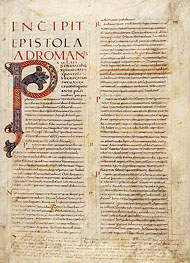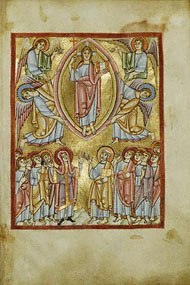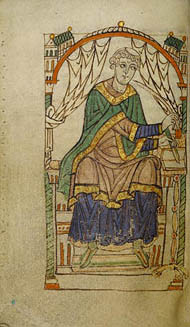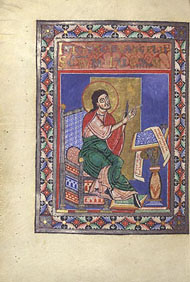|
From about 800 to 1200 monasteries functioned as the primary guardians of art and scholarship throughout Europe. Although these religious institutions were physically secluded, their scribes and illuminators created luxurious manuscripts for both the Church and the most powerful political leaders of the day.
The early medieval period saw the beginnings of a unified Europe under the Carolingian and Ottonian Empires. Educational and religious reforms during this time led to a dramatic increase in manuscripts created in monasteries. In the 1100s, manuscript production changed to meet the needs of new religious groups that emerged from reforms occurring within the monastic community. By 1200, the rise of universities and cities had shifted manuscript production to a growing class of secular artisans.
|
 |
|
The page above depicts Bernward (died 1022), a statesman, religious leader, and great patron of the arts. The manuscript was painted about 150 years after his death by monks of the abbey of Saint Michael, which was founded by Bernward. Several of them appear in the miniature and its painted frame. The monk Heinrich of Midel kneels at Bernward's feet, pleading, "Remember your congregation."
|
 |

 |
 |
Decorated Initial P, Tours, about 845
|
 |
 |
Throughout the period of Carolingian rule (771–843), monasteries served as centers of scholarship. For Charlemagne, the founding ruler of the Empire, they played a key role in his efforts to revive the Roman Empire, using education to return his people to the glorious culture of Christian Rome.
This elaborate initial P opens the biblical text to Saint Paul's letter to the Romans. It was once part of a large Bible written and illuminated at the abbey of Saint Martin of Tours. Decorated initials made in the Carolingian Empire were inspired in part by those in sixth- and seventh-century manuscripts from Ireland and the British Isles. The acanthus leaves and scrolls inside the letter are motifs borrowed from ancient Roman art.
|
 |
 |

 |
 |
The Ascension, Regensburg, about 1030–40
|
 |
Rulership during the Ottonian Empire (919–1024) was characterized by a blending of religious and political power. The Ottonian emperors presented themselves as Christ's representatives on earth, possessing authority that was divinely ordained. Church ceremony was central to Ottonian culture and the primary focus of monastic scribes and illuminators was manufacturing service books for the Mass.
The flat, otherworldly style was appropriate for books that were displayed on the altar during the Mass.
The figures in this image resemble actors in a religious drama. Mary and Peter stand at the center of the group of apostles and gesture with long, attenuated fingers toward Christ. Christ is slightly larger than the figures below, a device used to identify visually the most important person in a scene.
|
 |

 |
 |
Portrait of Eadmer of Canterbury, Benedictine abbey of Saint Martin, Tournai, about 1140–50
|
 |
 |
|
|
 |
By the mid-11th century, reforms in monasteries across Europe resulted in new religious orders, which in turn created new manuscripts specific to their needs. In this book, the monk Eadmer describes the life of his former archbishop, Anselm of Canterbury (1033–1109). Anselm was known for his theological writings as well as his attempts to free his church from the interference of the English kings.
Here, the author Eadmer is portrayed leaning over his writing table. The stylized curves and rhythmic patterns of the drapery are typical of Romanesque art. The simple style of the illumination, with large areas of blank page and limited use of gold, may reflect its use. Unlike ornate books for the Mass, this biography would have been intended for the monks' private reading practice.
|
 |
 |

 |
 |
Saint Luke, Benedictine abbey of Helmarhausen, about 1120–1140
|
 |
 |
|
In medieval Gospel books, an image of the author usually prefaces each of the four individual accounts of Jesus' life. The tradition of portraying the author in his text originated in antiquity. This image of Saint Luke writing his Gospel illustrates, in part, the working methods of a medieval scribe. An unbound parchment leaf lies on a sloping lectern along with several ink pots. Luke pauses in his work to sharpen his quill pen with a knife, which could also be used to scratch away mistakes in the parchment. The stylized patterns of Luke's robe, large areas of rich color, and treatment of space in this miniature are characteristic of Romanesque illumination.
|
 |




